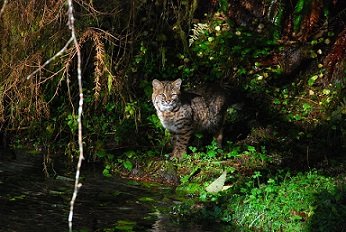
Bobcats are adaptable creatures, much like a Swiss Army knife. They can thrive in various environments, from thick woodlands to arid deserts. Imagine a crafty explorer who knows how to find food and shelter in almost any landscape; that’s the bobcat for you. As we dive into this topic, we’ll explore their habitats and distribution, giving you a clearer picture of where these fascinating animals roam.
What is a Bobcat?
Before we jump into where bobcats live, let’s take a moment to understand what they are. A bobcat is a medium-sized wild cat native to North America. They are typically about 24 to 40 inches long, with a distinctive “bobbed” tail that gives them their name. Their fur is usually spotted or striped, which helps them blend into their surroundings, making them exceptional hunters. Bobcats are solitary animals, often roaming alone, and they primarily hunt for rabbits, rodents, and birds.
Their adaptability is a key factor in their survival. You might be wondering how a creature can thrive in such different habitats. Well, bobcats are opportunistic predators, meaning they will eat whatever is available based on their environment. This flexibility is a big reason why they can be found in various regions across the continent.
Bobcat Habitat Preferences
Bobcats are truly versatile when it comes to their habitats. They prefer areas with a mix of cover and open space, allowing them to stalk prey while having spots to hide. Think of it like a cozy café where you can sip your coffee and have a great view—bobcats want to see their surroundings but also have places to retreat.
Here are some common habitat types where you’ll find bobcats:
- Forests: Bobcats thrive in both deciduous and coniferous forests. These areas offer dense cover, essential for hunting and hiding.
- Brushlands: Low shrubs and small trees provide excellent camouflage, making it easier for bobcats to stalk their prey.
- Deserts: Surprisingly, bobcats can adapt to arid environments, using the sparse vegetation to their advantage.
- Mountainous Regions: They can navigate rocky terrains, often leveraging cliffs and ledges for hunting.
You might also notice that bobcats avoid heavily populated areas. They prefer to stay away from urban environments, as too much human activity can disrupt their hunting patterns and living spaces.
Geographic Distribution of Bobcats
So, where exactly can you find bobcats? Their range is quite impressive. Bobcats are primarily located throughout the United States, stretching from southern Canada down to Mexico. It’s like having a sprawling backyard where they can roam freely.
Here’s a breakdown of their distribution:
- Western United States: States like California and Nevada have large populations due to the diverse habitats available.
- Midwestern States: Areas like Ohio and Michigan also support bobcat populations, thanks to their forested regions.
- Southeastern U.S.: Bobcats thrive in the forests of states like Florida and Georgia, where the climate is favorable.
- Northern Canada: They can even be found in southern parts of Canada, where their adaptability continues to shine.
You can see that bobcats are not picky when it comes to geography. They have successfully colonized various regions, making them one of the most widespread wild cats in North America.
How Bobcats Adapt to Different Habitats
Adapting to different habitats is one of the bobcat’s superpowers. Their physical characteristics and behaviors allow them to thrive, regardless of the environment. For instance, in dense forests, their camouflaged fur helps them remain hidden from both prey and potential threats. In arid regions, they can be more active during cooler parts of the day to avoid the heat.
Let’s break down some of their adaptations:
- Camouflage: Their spotted coats blend perfectly with natural surroundings, making it easier to sneak up on prey.
- Hunting Skills: Bobcats have sharp claws for climbing and strong legs for jumping, allowing them to navigate through different terrains efficiently.
- Territorial Behavior: They are known to mark their territory with scent markings, which helps reduce conflicts with other bobcats.
These adaptations not only enhance their survival but also make bobcats fascinating examples of how wildlife can thrive amidst changing environments.
Bobcat Populations and Conservation Status
Even though bobcats are adaptable, it doesn’t mean they are free from challenges. Their populations can be affected by factors like habitat loss, hunting, and climate change. Fortunately, bobcats are not currently considered endangered. Their adaptability has allowed them to bounce back from past declines, but conservation efforts remain essential.
Here are a few ways to help protect bobcat populations:
- Preserving Natural Habitats: Supporting conservation areas helps maintain the landscapes bobcats rely on.
- Responsible Hunting Practices: Advocating for sustainable hunting ensures that bobcat populations remain stable.
- Awareness and Education: Educating others about the importance of bobcats in the ecosystem can help foster respect for wildlife.
As we become more aware of their needs, we can take steps to coexist peacefully with these incredible creatures.
Bobcats are remarkable animals that have learned to thrive in various habitats across North America. From dense forests to open deserts, they remind us of nature’s resilience. By understanding where bobcats live and how they adapt, we can appreciate their role in the ecosystem and contribute to their conservation.
Whether you’re hiking in the woods or simply enjoying a quiet evening, keep an eye out for these stealthy hunters. They might just be watching you, too! Let’s work together to ensure that bobcats and their habitats are protected for generations to come.
